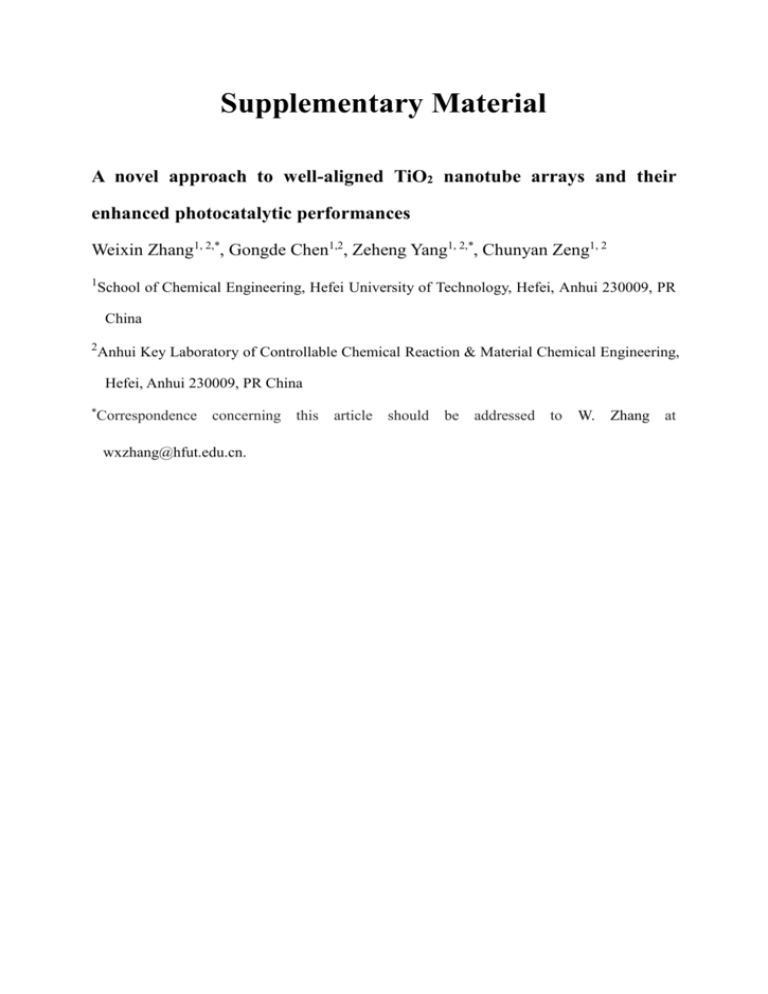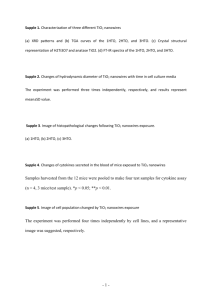aic13985-sup-0001-suppinfo
advertisement

Supplementary Material A novel approach to well-aligned TiO2 nanotube arrays and their enhanced photocatalytic performances Weixin Zhang1, 2,*, Gongde Chen1,2, Zeheng Yang1, 2,*, Chunyan Zeng1, 2 1 School of Chemical Engineering, Hefei University of Technology, Hefei, Anhui 230009, PR China 2 Anhui Key Laboratory of Controllable Chemical Reaction & Material Chemical Engineering, Hefei, Anhui 230009, PR China * Correspondence concerning this article should be addressed to wxzhang@hfut.edu.cn. W. Zhang at 101 35000 25000 20000 116 204 213 103 112 5000 105 211 10000 200 15000 004 Intensity (cps) 30000 0 10 20 30 40 50 2Theta (degrees) Figure S1. XRD pattern of commercial TiO2 powder. 60 70 a b 2 μm 20 μm c d 500 nm 200 nm Figure S2. FESEM images of TiO2 nanotube arrays without post-heating. (a) low magnification, (b) cross section, (c) close-tip nanostructure, and (d) broken nanostructure. a 15 μm 10 μm b Figure S3. Cross-sectional SEM images of (a) TiO2 nanotube arrays and (b) commercial TiO2 nanoparticle film. a b 100 nm c 100 nm 100 nm d 100 nm Figure S4. High magnification TEM images of TiO2 nanotube annealed at (a) 300 oC, (b) 400 o C, (c) 500 oC, and (d) 600 oC for 4 h. a b 100 nm 100 nm c 100 nm d 100 nm Figure S5. High magnification TEM images of TiO2 nanotube annealed at 500 oC for (a) 1 h, (b) 2 h, (c) 4 h, and (d) 6 h. 1.0 C/C0 0.8 0.6 0.4 0.2 a b 0.0 0 30 60 90 120 150 180 210 Time (min) Figure S6. Photocatalytic degradation of RhB solution in the presence of the anatase TiO2 nanotube arrays under UV light irradiation (a) with and (b) without stirring. (The systems were placed in the dark for 30 min beforehand) Table S1. Summary of the regression equations of the RhB concentration C versus UV light irradiation time t and their values of coefficient of determination R2 with respect to increased initial concentration C0. C0 (mg/L) Regression equation R2 2 C 1.7196 exp(0.0439t ) 0.9980 4 C 3.4693exp(0.0402t ) 0.9978 6 C 5.6472 exp(0.0371t ) 0.9985 8 C 7.6796 exp(0.0288t ) 0.9977 1.0 C/C0 0.8 0.6 0.4 0.2 0.0 0 30 60 90 120 150 180 210 Time (min) Figure S7. The plot of the relative concentration of RhB versus UV light irradiation time in the presence of the anatase TiO2 nanotube arrays. The systems were placed in the dark for 30 min beforehand. Each point represents the average value of five separate experiments, and the vertical line represents the error range. 3 -1 -1 dV/dD ( cm kg nm ) ) -1 3 Volume absorbed (cm g 90 80 70 60 50 40 a 1.6 1.4 1.2 1.0 0.8 0.6 0.4 0.2 0.0 0 30 20 10 0 0.0 20 40 60 80 Pore diameter (nm) 0.2 0.4 100 0.6 0.8 Relative pressure (P/P0) 80 70 b ) -1 -1 90 1.5 3 100 2.0 1.0 dV/dD (cm kg nm 3 Volume absorbed (cm g -1 ) 120 110 1.0 0.5 0.0 0 20 40 60 80 Pore diameter (nm) 100 60 50 40 0.0 0.2 0.4 0.6 0.8 1.0 Relative pressure (P/P0) Figure S8. N2 absorption-desorption isothermal curves of TiO2 nanotubes scrapped from the copper substrates (a) annealed at 500 oC for 2 h and (b) without post-heating. The insets show the corresponding pore size distributions calculated by the BJH method. -1 -1 3 30 dV/dD ( cm kg nm ) -1 35 3 Volume absorbed ( cm g ) 40 25 20 15 0.65 0.60 0.55 0.50 0.45 0.40 0.35 0.30 0 10 20 40 60 80 Pore diameter (nm) 100 5 0 0.0 0.2 0.4 0.6 0.8 Relative pressure ( P/P0) 1.0 Figure S9. N2 absorption-desorption isothermal curves of the commercial anatase TiO2 nanoparticles. The inset shows the corresponding pore size distributions calculated by the BJH method. Figure S10. Digital photo of the anatase TiO2 nanotube arrays on copper substrates with different film areas.





